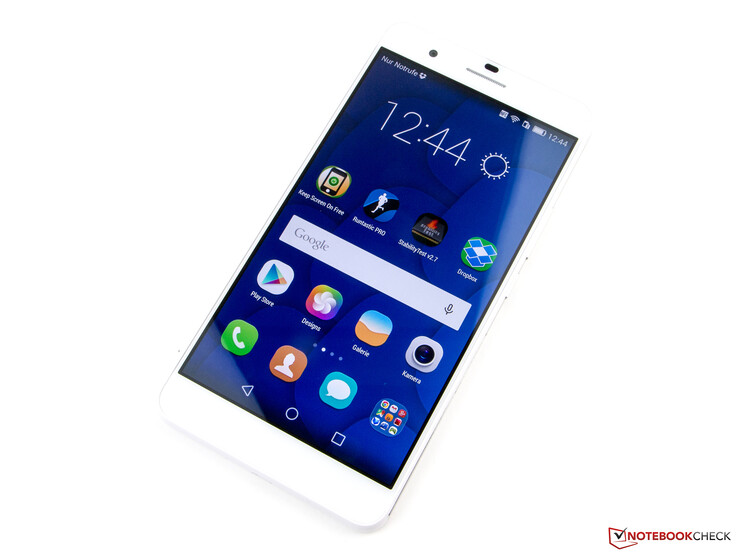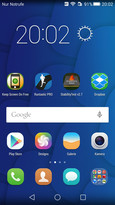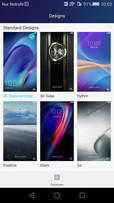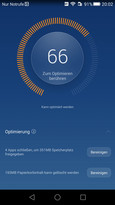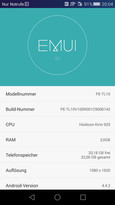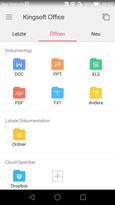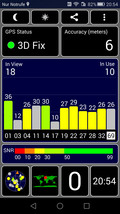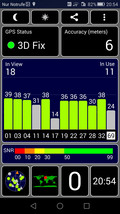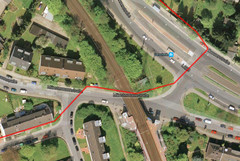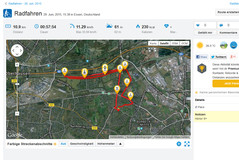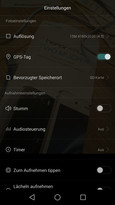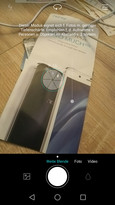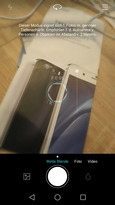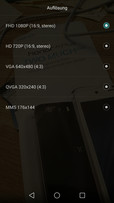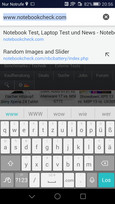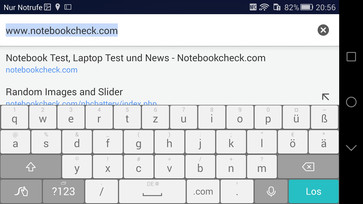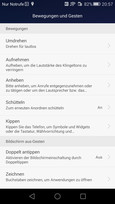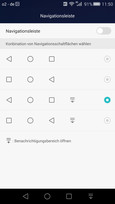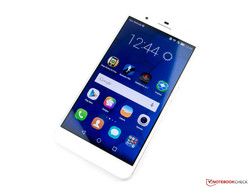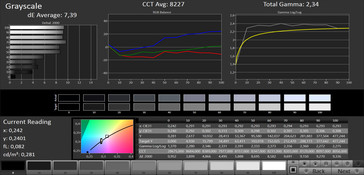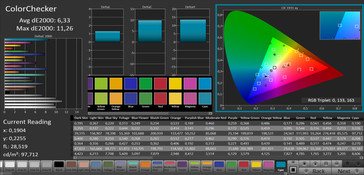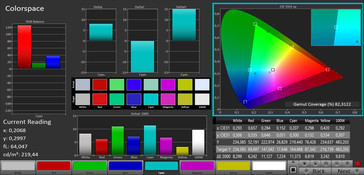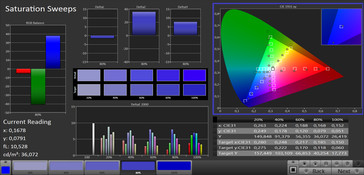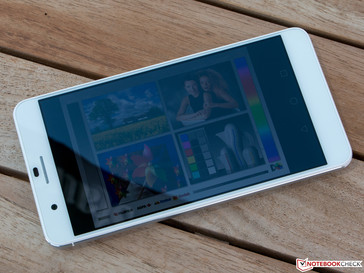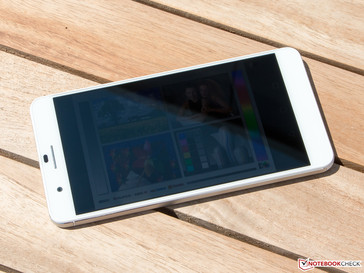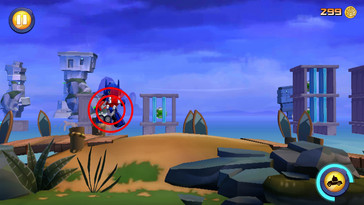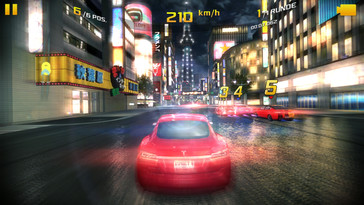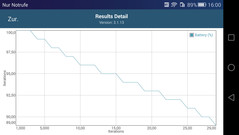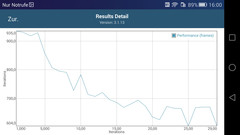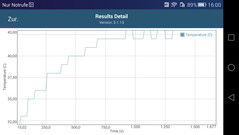Honor 6 Plus Smartphone Review
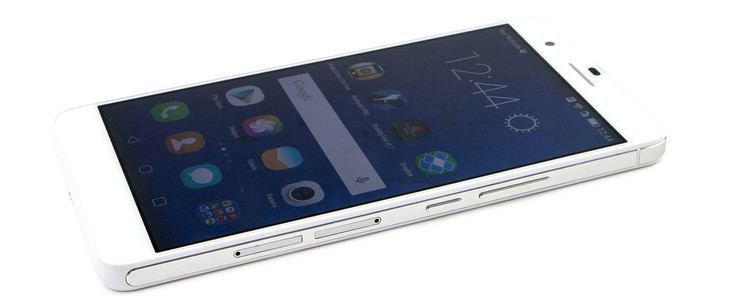
For the original German review, see here.
The Honor 6 Plus is a 5.5-inch smartphone for 400 Euros (~$437) that scares off the competition with its features, at least on paper. The technical equipment does not really leave anything to be desired, but you should not expect new records in terms of performance. As expected, the smartphone is equipped with a Kirin processor from the parent group Huawei. Still, the P8 already showed that the performance is completely sufficient and provides a smooth user experience. One key feature is the dual-camera of the Honor 6+, which is also supposed to take good pictures in difficult lighting situations.
In the same price range are rivals like the HTC Desire Eye and Samsung Galaxy A5, and also the Huawei P8 which is just slightly more expensive. The majority of high-end smartphones from 2014 is now in this price range as well.
Case
The chassis of the Honor 6+ is made of durable fiber-glass. The alleged aluminum frame is made of plastic as well but looks quite appealing. This impression is also supported by the comparatively high weight of 164 grams. Honor specifies the height with 7.5 millimeters, but the smallest height we could measure was 7.65 millimeters, while the frame is almost 8 millimeters high.
The smartphone is very sturdy and there is just slight creaking when we try to twist it. Pressure is no problem for the Honor 6+, either, only heavy pressure directly on the display can create some ripples on the screen.
The battery of the smartphone is integrated. The two slots on the right side of the Honor 6+ are, unfortunately, not flush with the rest of the case but sit slightly deeper. The first slot can be equipped with a Micro-SIM card, the other one either with a Nano-SIM or a microSD card.
Connectivity
The Micro-USB 2.0 port of the Honor 6+ can be used to charge the smartphone and transfer files to a PC. It also supports OTG, so it is possible to attach external drives or input devices. MHL 2.0 is available as well, so you can transfer the display content to a TV with an optional cable. DLNA and Wi-Fi Direct are also integrated.
The microSD slot supports memory cards with a capacity of up to 128 GB. It is no problem to transfer apps to the additional storage (App2SD), but it is, unfortunately, not possible to install them there directly.
Thanks to the infrared sensor and the app Smart Controller, you can control your own home cinema and the climate control.
Software
The Honor 6+ is shipped with Google Android 4.4.2 and Huawei’s user interface EMUI 3.0. Similar to the Honor 6 or the Huawei P8, you don’t get an app drawer. We already know the Smartphone Manager from other models and it can be used to optimize the smartphone. You also get some handy little tools like a magnifier, a radio and a flashlight. Besides the Google apps, there is only one preloaded third-party app, the Office Suite from Kingsoft.
An update to Google Android 5.0.1 Lollipop and EMUI 3.1 is currently in the works and is supposed to be released this year.
Communication & GPS
The Honor 6+ was announced with dual-band Wi-Fi at the Mobile World Congress 2015 in Barcelona, but the actual production unit only supports the IEEE 802.11 standards b/g/n, which means you can only use 2.4 GHz networks. But the signal quality and the range are pretty good in return. The Honor 6+ can still recognize 5 GHz networks, but the signal quality is not very good in this case.
Mobile Internet connections can be established via HSPA+ (up to 42 Mbps) and LTE (up to 150 Mbps), but we miss the 800 MHz band for the latter. It should, however, work well in Asia thanks to the support of many TDD LTE frequencies. The signal quality was really good. It just seems that the Honor 6+ prefers the HSPA connection instead of the faster but also power-hungry LTE. While the Lumia 930 immediately connected to the LTE network of O2, the review unit only used HSPA+ but with a better signal quality.
Bluetooth is only available in version 4.0 but worked really well in our review.
The position of the smartphone can be located via GPS, Glonass and BeiDou. The satellite fix is also very fast and precise indoors. Outdoors, the accuracy is down to six meters, so we cannot criticize the performance.
We compared the accuracy of the Honor 6+ with the outdoor navigation device Garmin GPSMAP 64s. The smartphone does a pretty good job and the overall track length differs by around 500 meters from the professional device, which is slightly more than 2%. The reason is that the smartphone does not locate the position as often and therefore takes some shortcuts, which is easy to see in the bridge section.
Telephone & Voice Quality
The voice quality of the Honor 6+ is pretty decent and is sufficient for phone calls. Voices are slightly distorted on both sides, which does not create a natural sound, but it is otherwise free of distortions and allows convenient conversations. The speaker of the device leaves a good impression in quiet environments. It echoes just a bit, and it does not make an audible difference whether we hold the smartphone in our hand or if it is lying next to us on the table.
Cameras
Smartphones are continuing to get better cameras. The Honor 6+ has an 8 MP sensor at the front (3264x2448 pixels, 4:3, f/2.4), which is great news for selfie fans. You should only be careful with the automatic picture retouching because it uses a very strong soft focus, which can create a very artificial look at the highest setting. Both cameras offer many options and can also be triggered with a smile or via voice command, for example.
At the back is a dual-camera consisting of two 8 MP sensors that create one image with around 13 MP (4160x3120 pixels, 4:3, f/2.0). This is supposed to create good pictures, especially in difficult lighting conditions. HTC tried a similar thing with the One M8 and failed miserably, but Honor does a better job. The pictures are actually pretty sharp and the environment is bright when the lighting is bad, but you have to live with small fragments in return. Neither the Samsung Galaxy S6 nor the LG G4 have this problem, but the pictures are not quite as sharp. The edges of the Samsung device in particular appear a bit soft. The Lumia 930 is still undefeated in respect of the sharpness. The results of the LG G4 appear a bit more balanced, but the Honor 6+ still works very well.
The dual-camera also works well under daylight, but the pictures are not as sharp and detailed compared to the high-end competition. The peripheral areas in particular lack sharpness. We like the color reproduction, which leaves a comparatively natural impression. The dynamic range should be higher without HDR, which has to be activated manually. The short trigger time is great and reminds us of the Huawei P8, especially since the ultra-snapshot mode is also available and can be used to take a snapshot within one second with a double tap on the volume-down button.
The super-night mode implements a simplified long-term exposure, but it requires a solid underground or even better, a tripod. The function Wide Aperture simulates aperture ratios of f/0.95 up to f/16, but it does not improve the light sensitivity and just simulates an objective vignetting.
Videos on the Honor 6+ can be recorded in Full HD (1920x1080 pixels, 16:9, 30 fps). Sound is recorded in stereo and is a bit dull, but the picture quality is decent in return. There are also some features for videos like object tracking, but there is, unfortunately, no time-lapse or slow-motion feature.
All in all, Honor equips its flagship device with a good camera, but it cannot quite keep up with the high-end competition. It is well-suited for snapshots and medium-sized copies.
Accessories
The Honor 6+ is shipped with a modular power adaptor, a USB cable, a quick-start guide as well as a small SIM tool. Optional accessories are currently not available, but there are some in the pipeline.
Warranty
Honor grants a warranty of 24 months for its product.
Input Devices & Handling
The capacitive touchscreen of the Honor 6+ recognizes up to ten inputs simultaneously, and it has very good gliding capabilities. Even two fingers close to each other are recognized without problems, and there are no problems in the peripheral areas, either. Inputs are executed quickly and precisely.
The Android buttons of the Honor 6+ are on-screen buttons. This does reduce the visible screen area in some situations, but the majority of apps can fade them out. It is also possible to adjust the navigation bar to your own preferences. You can, for example, add another input field that gives direct access to the notification center.
The keyboard layout is identical to the Huawei P8 and offers language-specific adjustments. The keyboard layout is simple and allows a smooth typing experience. Swype inputs are supported just like automatic word predictions above the keyboard. You only have to live without a one-hand mode.
Display
The Full HD display (1920x1080 pixels) of the Honor 6+ measures 5.5-inches. This corresponds with an aspect ratio of 16:9 and a pixel density of around 401 PPI, which means content is razor sharp. The subjective impression of the display is very good with rich colors and a very even brightness distribution.
The luminance of the review unit is convincing as well at up to 488 cd/m², even though it is still clearly beaten by the HTC Desire Eye, which manages an impressive value of 635 cd/m².
| |||||||||||||||||||||||||
Brightness Distribution: 93 %
Center on Battery: 472 cd/m²
Contrast: 1686:1 (Black: 0.28 cd/m²)
ΔE ColorChecker Calman: 6.33 | ∀{0.5-29.43 Ø4.78}
ΔE Greyscale Calman: 7.39 | ∀{0.09-98 Ø5}
Gamma: 2.34
CCT: 8227 K
| Honor 6 Plus Mali-T628 MP4, Kirin 925, 32 GB eMMC Flash | Honor 6 Mali-T628 MP4, Kirin 920, 16 GB eMMC Flash | Huawei P8 Mali-T628 MP4, Kirin 930, 16 GB eMMC Flash | HTC Desire EYE Adreno 330, 801 MSM8974AB, 16 GB eMMC Flash | Samsung Galaxy A5 Adreno 306, 410 MSM8916, 16 GB eMMC Flash | Sony Xperia Z3 Compact Adreno 330, 801 MSM8974AC, 16 GB eMMC Flash | LG G4 Adreno 418, 808 MSM8992, 32 GB eMMC Flash | Apple iPhone 6 Plus PowerVR GX6450, A8, 64 GB eMMC Flash | |
|---|---|---|---|---|---|---|---|---|
| Screen | -41% | 6% | 3% | 25% | -18% | -7% | -10% | |
| Brightness middle (cd/m²) | 472 | 439 -7% | 453 -4% | 635 35% | 482 2% | 513 9% | 566 20% | 519 10% |
| Brightness (cd/m²) | 471 | 439 -7% | 439 -7% | 631 34% | 432 -8% | 500 6% | 536 14% | 496 5% |
| Brightness Distribution (%) | 93 | 93 0% | 91 -2% | 92 -1% | 85 -9% | 94 1% | 90 -3% | 90 -3% |
| Black Level * (cd/m²) | 0.28 | 0.8 -186% | 0.28 -0% | 0.54 -93% | 0.41 -46% | 0.47 -68% | 0.62 -121% | |
| Contrast (:1) | 1686 | 549 -67% | 1618 -4% | 1176 -30% | 1251 -26% | 1204 -29% | 837 -50% | |
| Colorchecker dE 2000 * | 6.33 | 7.06 -12% | 4.7 26% | 4.11 35% | 2.15 66% | 8.54 -35% | 6.17 3% | 3.67 42% |
| Greyscale dE 2000 * | 7.39 | 8.08 -9% | 5.03 32% | 4.29 42% | 1.81 76% | 9.88 -34% | 6.26 15% | 3.78 49% |
| Gamma | 2.34 94% | 2.16 102% | 2.27 97% | 2.59 85% | 2.42 91% | 3.03 73% | 2.48 89% | 2.42 91% |
| CCT | 8227 79% | 8134 80% | 7439 87% | 6956 93% | 6626 98% | 8659 75% | 8171 80% | 7327 89% |
| Color Space (Percent of AdobeRGB 1998) (%) | 72.04 | 65.48 | ||||||
| Color Space (Percent of sRGB) (%) | 98.63 |
* ... smaller is better
The black value of the Honor 6 Plus is identical to the Huawei P8 (0.28 cd/m², 1,618:1) and is really good. Thanks to the slightly higher brightness, you even get a better contrast ratio. The smartphone manages the highest value in our comparison group and can only be beaten by a rival with an OLED display.
We checked the color accuracy with a photo spectrometer and the software CalMAN. The grayscale quickly shows a slight blue cast, and the deviations from the ideal value are pretty high with a DeltaE over 7. It is basically the same situation for the ColorChecker, where the average deviation of the Honor 6+ is a bit better, but there are pretty big outliers in the blue spectrum. This was, however, no problem in practice. It is even possible to adjust the panel according to your own preferences thanks to a manual white balance.
The outdoor capabilities of the Honor 6+ are decent. Reflections are reduced by the LTPS technology, and the high contrast ensures a good visibility of the screen even in bright environments. It is still not possible to watch a movie under direct sunlight, but this is a problem for pretty much every mobile device.
The viewing-angle stability of the LTPS panel inside the Honor 6+ is excellent. The colors are stable from every position and there are no ghost effects. You can only see a slight glow effect when you look at the display from extreme positions from an angle above or below.
Performance
The Honor 6 Plus uses the 32-bit SoC HiSilicon Kirin 925 with eight cores. It still consists of an older big.LITTLE configuration with four Cortex A7 and Cortex A15 cores each, which are clocked at 1.3 and 1.8 GHz, respectively. You also get 3 GB RAM and the integrated graphics card ARM Mali-T628 MP4, a powerful chip that we already know from the older Huawei Ascend Mate 7.
Our benchmarks show that the review unit is even a bit faster than the older sibling and is only beaten by the HTC Desire Eye (Snapdragon 801) and sometimes by the Huawei P8 (Kirin 930). The system performance is also very good. Micro stutters are hardly perceptible at all. It is, however, unfortunate that Honor did not use a 64-bit SoC, which would have resulted in a small performance gain with the upcoming update to Lollipop 5.1.
| Smartbench 2012 | |
| Productivity Index (sort by value) | |
| Honor 6 Plus | |
| Honor 6 | |
| Huawei P8 | |
| HTC Desire EYE | |
| Samsung Galaxy A5 | |
| Gaming Index (sort by value) | |
| Honor 6 Plus | |
| Honor 6 | |
| Huawei P8 | |
| HTC Desire EYE | |
| Samsung Galaxy A5 | |
| Linpack Android / IOS | |
| Single Thread (sort by value) | |
| Honor 6 Plus | |
| Honor 6 | |
| Huawei P8 | |
| HTC Desire EYE | |
| Samsung Galaxy A5 | |
| Multi Thread (sort by value) | |
| Honor 6 Plus | |
| Honor 6 | |
| Huawei P8 | |
| HTC Desire EYE | |
| Samsung Galaxy A5 | |
| AnTuTu v5 - Total Score (sort by value) | |
| Honor 6 Plus | |
| Honor 6 | |
| Huawei P8 | |
| HTC Desire EYE | |
| Samsung Galaxy A5 | |
| Huawei Ascend Mate 7 | |
| 3DMark | |
| 1280x720 offscreen Ice Storm Unlimited Score (sort by value) | |
| Honor 6 Plus | |
| Honor 6 | |
| Huawei P8 | |
| HTC Desire EYE | |
| Samsung Galaxy A5 | |
| Huawei Ascend Mate 7 | |
| 1280x720 offscreen Ice Storm Unlimited Graphics Score (sort by value) | |
| Honor 6 Plus | |
| Honor 6 | |
| Huawei P8 | |
| HTC Desire EYE | |
| Samsung Galaxy A5 | |
| Huawei Ascend Mate 7 | |
| 1280x720 offscreen Ice Storm Unlimited Physics (sort by value) | |
| Honor 6 Plus | |
| Honor 6 | |
| Huawei P8 | |
| HTC Desire EYE | |
| Samsung Galaxy A5 | |
| Huawei Ascend Mate 7 | |
| GFXBench (DX / GLBenchmark) 2.7 | |
| T-Rex Onscreen (sort by value) | |
| Honor 6 Plus | |
| Honor 6 | |
| Huawei P8 | |
| HTC Desire EYE | |
| Samsung Galaxy A5 | |
| 1920x1080 T-Rex Offscreen (sort by value) | |
| Honor 6 Plus | |
| Honor 6 | |
| Huawei P8 | |
| HTC Desire EYE | |
| Samsung Galaxy A5 | |
| GFXBench 3.0 | |
| on screen Manhattan Onscreen OGL (sort by value) | |
| Honor 6 Plus | |
| Honor 6 | |
| Huawei P8 | |
| HTC Desire EYE | |
| Samsung Galaxy A5 | |
| Huawei Ascend Mate 7 | |
| 1920x1080 1080p Manhattan Offscreen (sort by value) | |
| Honor 6 Plus | |
| Honor 6 | |
| Huawei P8 | |
| HTC Desire EYE | |
| Samsung Galaxy A5 | |
| Huawei Ascend Mate 7 | |
| Geekbench 3 | |
| 32 Bit Single-Core Score (sort by value) | |
| Honor 6 Plus | |
| Honor 6 | |
| Huawei P8 | |
| HTC Desire EYE | |
| Samsung Galaxy A5 | |
| Huawei Ascend Mate 7 | |
| 32 Bit Multi-Core Score (sort by value) | |
| Honor 6 Plus | |
| Honor 6 | |
| Huawei P8 | |
| HTC Desire EYE | |
| Samsung Galaxy A5 | |
| Huawei Ascend Mate 7 | |
We checked the browser performance with the preloaded Google Chrome 43. Subjectively, websites opened quickly and the benchmarks confirm this impression as well.
| Octane V2 - Total Score (sort by value) | |
| Honor 6 Plus | |
| Honor 6 | |
| Huawei P8 | |
| HTC Desire EYE | |
| Samsung Galaxy A5 | |
| Huawei Ascend Mate 7 | |
| Sunspider - 1.0 Total Score (sort by value) | |
| Honor 6 Plus | |
| Honor 6 | |
| Huawei P8 | |
| HTC Desire EYE | |
| Samsung Galaxy A5 | |
| Huawei Ascend Mate 7 | |
| BaseMark OS II - Web (sort by value) | |
| Honor 6 Plus | |
| Honor 6 | |
| Huawei P8 | |
| HTC Desire EYE | |
| Mozilla Kraken 1.1 - Total (sort by value) | |
| Honor 6 Plus | |
| Honor 6 | |
| Huawei P8 | |
| HTC Desire EYE | |
| Samsung Galaxy A5 | |
| Huawei Ascend Mate 7 | |
| WebXPRT 2015 - Overall (sort by value) | |
| Honor 6 Plus | |
| Huawei P8 | |
* ... smaller is better
The Honor 6+ is equipped with 32 GB eMMC storage, and almost 26 GB can be used for your own files. The is quite a lot in this price range, but the storage is not very fast in return, even though the competition is not that fast in general. The performance is at least much better compared to the Honor 6.
The storage can be expanded by up to 128 GB via microSD card. We checked the performance with the fast memory card Toshiba Exceria (CX32UHS1, UHS-I Class 3, read: 85 MB/s, write: 55 MB/s). The result was sobering. We only measured 10.32 MB/s during writing, but it was at least twice as fast during reading. The performance is still sufficient to store videos directly onto the memory card. You only have to expect longer waiting times when you copy large files.
| AndroBench 3-5 | |
| Sequential Read 256KB (sort by value) | |
| Honor 6 Plus | |
| Honor 6 | |
| Huawei P8 | |
| HTC Desire EYE | |
| Samsung Galaxy A5 | |
| Huawei Ascend Mate 7 | |
| Sequential Write 256KB (sort by value) | |
| Honor 6 Plus | |
| Honor 6 | |
| Huawei P8 | |
| HTC Desire EYE | |
| Samsung Galaxy A5 | |
| Huawei Ascend Mate 7 | |
| Random Read 4KB (sort by value) | |
| Honor 6 Plus | |
| Honor 6 | |
| Huawei P8 | |
| HTC Desire EYE | |
| Samsung Galaxy A5 | |
| Huawei Ascend Mate 7 | |
| Random Write 4KB (sort by value) | |
| Honor 6 Plus | |
| Honor 6 | |
| Huawei P8 | |
| HTC Desire EYE | |
| Samsung Galaxy A5 | |
| Huawei Ascend Mate 7 | |
| BaseMark OS II - Memory (sort by value) | |
| Honor 6 Plus | |
| Honor 6 | |
| Huawei P8 | |
| HTC Desire EYE | |
Games
Games are no problem for the Honor 6+. The ARM Mali-T628 MP4 is powerful enough and supports modern graphics interfaces like OpenGL ES 3.0. More demanding titles like Asphalt 8 run just as smoothly as Angry Birds Transformers (see video).
The well working sensors, the good touchscreen and the great display complete the good gaming experience, only the speaker can be quickly covered by the finger when you hold the smartphone in landscape mode.
Emissions
Temperature
The Honor 6+ already gets lukewarm while idling and the surface temperatures can reach up to 44.4 °C under load. The two competitors stay much cooler and the Desire Eye stays below 36 °C despite the faster SoC. Still, the results are not critical by any means.
We performed a stress test with the GFXBench 3.1 Battery test. It runs the OpenGL ES 2.0 test T-Rex thirty times in a row while the battery capacity, the frame rate as well as the temperature of the SoC are logged. The performance of the Honor 6+ actually dropped to two-thirds of the original performance over the course of the test.
(±) The maximum temperature on the upper side is 44.4 °C / 112 F, compared to the average of 35.2 °C / 95 F, ranging from 21.9 to 247 °C for the class Smartphone.
(±) The bottom heats up to a maximum of 40.7 °C / 105 F, compared to the average of 34 °C / 93 F
(±) In idle usage, the average temperature for the upper side is 33.1 °C / 92 F, compared to the device average of 32.9 °C / 91 F.
Speakers
The speaker of the Honor 6+ is located at the back. The position is not perfect, because you can easily cover it with a finger when you use the smartphone in landscape mode. The sound is also muffled on flat surface like a table due to the flat rear.
The sound itself is pretty balanced and clean up to a maximum volume of 50%, but there will be distortions after that. This is particularly noticeable when you listen to music. Rock music sometimes becomes a distorted screaming at the maximum setting. We therefore recommend headphones or external speakers, but the quality will be sufficient for occasional playback in quiet environments.
The stereo jack subjectively works without problems and there was hardly any signal noise.
Energy Management
Power Consumption
The Honor 6+ is not a particularly frugal device and consumes quite a lot power. Only the smaller sibling Honor 6 has similar power consumption but benefits from the smaller display. LG's G4 consumes more power under load.
The battery capacity is quite generous in return with 3,600 mAh and should be able to compensate for the higher consumption. The power adaptor has a nominal output of 10 Watts (2 Amps, 5 Volts) and is therefore powerful enough.
| Off / Standby | |
| Idle | |
| Load |
|
Key:
min: | |
| Honor 6 Plus Mali-T628 MP4, Kirin 925, 32 GB eMMC Flash | Honor 6 Mali-T628 MP4, Kirin 920, 16 GB eMMC Flash | Huawei P8 Mali-T628 MP4, Kirin 930, 16 GB eMMC Flash | Samsung Galaxy A5 Adreno 306, 410 MSM8916, 16 GB eMMC Flash | HTC Desire EYE Adreno 330, 801 MSM8974AB, 16 GB eMMC Flash | LG G4 Adreno 418, 808 MSM8992, 32 GB eMMC Flash | Apple iPhone 6 Plus PowerVR GX6450, A8, 64 GB eMMC Flash | |
|---|---|---|---|---|---|---|---|
| Power Consumption | 8% | 28% | 56% | 49% | 18% | 36% | |
| Idle Minimum * (Watt) | 1.6 | 1.7 -6% | 0.7 56% | 0.8 50% | 0.3 81% | 1.1 31% | 0.5 69% |
| Idle Average * (Watt) | 3 | 2.4 20% | 2 33% | 1.2 60% | 1.2 60% | 1.5 50% | 2.1 30% |
| Idle Maximum * (Watt) | 3.2 | 2.8 12% | 2.1 34% | 1.4 56% | 1.5 53% | 1.9 41% | 2.5 22% |
| Load Average * (Watt) | 5.6 | 5.3 5% | 4.9 12% | 1.9 66% | 3.8 32% | 6.6 -18% | 3.5 37% |
| Load Maximum * (Watt) | 7.6 | 6.8 11% | 7.4 3% | 4 47% | 6.2 18% | 8.8 -16% | 5.8 24% |
* ... smaller is better
Battery Runtime
The Honor 6+ can benefit from its powerful 3,600 mAh battery in the runtime tests and dominates the comparison group with good results in all scenarios. Our review unit lasts more than a day in the Reader’s Test and almost four hours under sustained maximum load.
Our tests with an adjusted display brightness (150 cd/m²) offer the best comparability. Both the video runtime test as well as the Wi-Fi test determine great results for the Honor 6+. Our new Wi-Fi test is more demanding, so the results cannot be directly compared to the old test. Those results are usually higher, but the Desire Eye could be one candidate that could have managed an even better result.
If you want to increase the runtimes even further, you can also find an ultra-energy-saving mode in the settings, but it does limit the functionality of the smartphone noticeably.
| Honor 6 Plus Mali-T628 MP4, Kirin 925, 32 GB eMMC Flash | Honor 6 Mali-T628 MP4, Kirin 920, 16 GB eMMC Flash | HTC Desire EYE Adreno 330, 801 MSM8974AB, 16 GB eMMC Flash | Samsung Galaxy A5 Adreno 306, 410 MSM8916, 16 GB eMMC Flash | Huawei P8 Mali-T628 MP4, Kirin 930, 16 GB eMMC Flash | LG G4 Adreno 418, 808 MSM8992, 32 GB eMMC Flash | Apple iPhone 6 Plus PowerVR GX6450, A8, 64 GB eMMC Flash | |
|---|---|---|---|---|---|---|---|
| Battery runtime | -45% | -20% | -15% | -24% | -30% | -11% | |
| Reader / Idle (h) | 27.4 | 23.9 -13% | 19.2 -30% | 13.8 -50% | 27.6 1% | 23.9 -13% | |
| H.264 (h) | 11.8 | 8.4 -29% | 10 -15% | 9.7 -18% | 8.4 -29% | 11.3 -4% | |
| WiFi v1.3 (h) | 8.9 | 7.2 -19% | 5.4 -39% | ||||
| Load (h) | 4 | 2.2 -45% | 3.3 -17% | 4 0% | 3.6 -10% | 1.9 -52% | 3.3 -17% |
| WiFi (h) | 7.6 | 15.2 | 8.9 | 13 |
Pros
Cons
Verdict
The Honor 6+ from Huawei’s subsidiary is a successful smartphone, which does have a good camera, but the high-contrast display and the great battery runtimes are even more convincing. The list of features is pretty comprehensive and lacks just a few options. The hybrid slot means users have the choice between a storage expansion via microSD card or dual-SIM LTE.
The Honor 6+ can compensate for its small flaws with great battery runtimes, good cameras as well as good features and offers everything you expect from a good smartphone.
The small issues primarily concern details. The colors of the panel are not very accurate, LTE lacks the 800 MHz band, the microSD slot is very slow, and the speaker could be better as well. However, all these small issues will hardly be noticeable in practice, which is why the Honor 6 Plus is still a really good smartphone.
Honor 6 Plus
- 07/29/2015 v4 (old)
Daniel Schmidt




